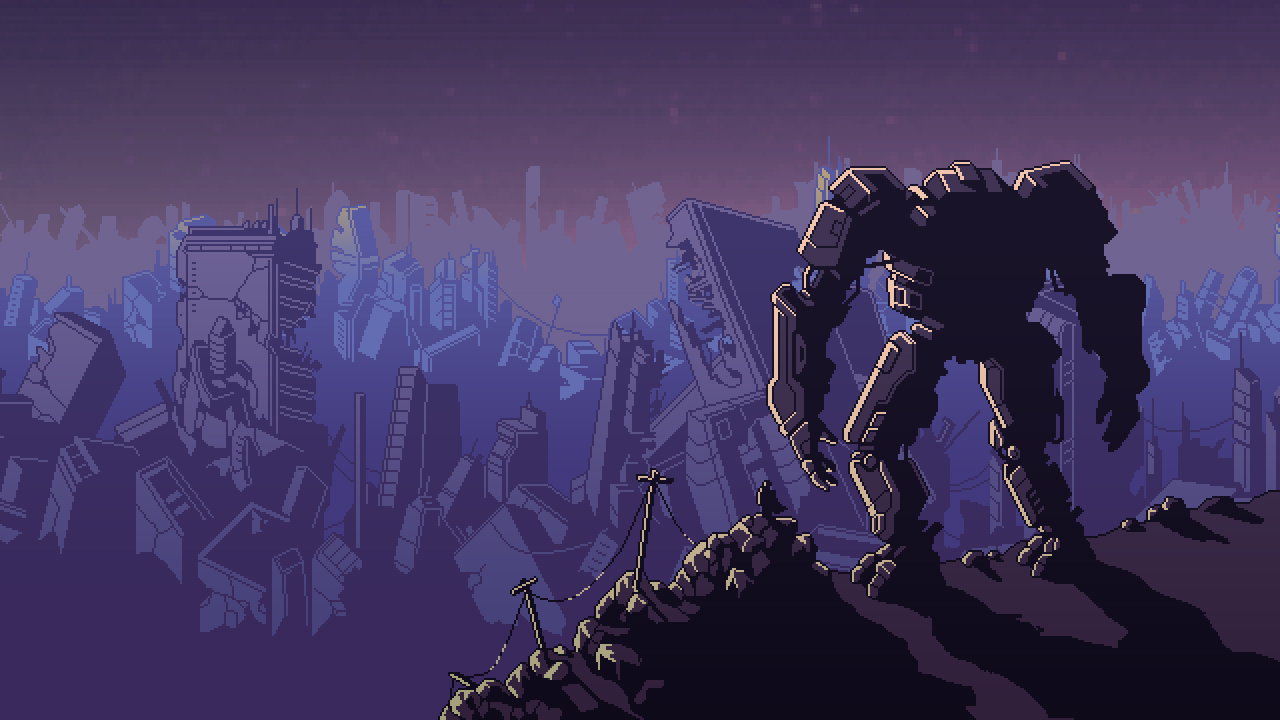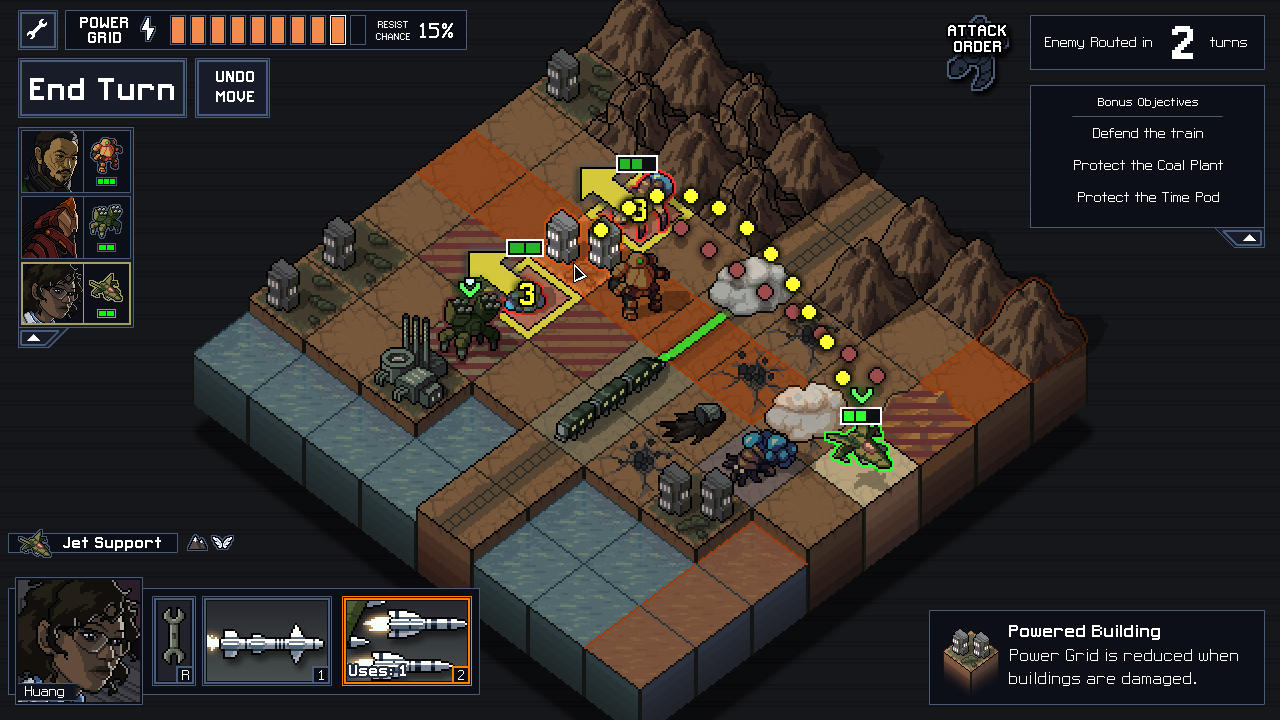Everything you need to know about Into the Breach, the next game from the developers of FTL
Into the Breach might be small in scope, but it reimagines turn-based strategy in a big way.

Into the Breach is out on February 27. While we wait for the FTL follow-up, here's our in-depth look at the new tactics game, originally published in September 2017.
Humanity was wiped out twice before I finally understood how to survive in Into the Breach. My Godzilla-sized mechs were overwhelmed by the insectoid Vek, helpless to stop as they butchered the last human cities. There is no game over in Into the Breach—not in the thematic sense. Instead, as the last vestiges of civilization were wiped out, a wormhole opened to send a single one of my pilots back to an alternate timeline to try again. And again. And again.
This cycle of trying, failing, learning, and trying again is one of the few things that binds Into the Breach to FTL, the indie smash hit and first game that Justin Ma and Matthew Davis made together. There are other threads that link the two games, but Into the Breach is not a spiritual successor in any real way. Instead, it’s a clever subversion of turn-based strategy games like XCOM done at a scale that makes it feel like a Gameboy Advance game.
Justin Ma and Matthew Davis gave me exclusive access to a prerelease build of Into the Breach. And after playing it for a week, I sat down with them to talk about how such a little game subverts the turn-based strategy genre in big ways.
“When you think of tactics games, especially with the popularity of XCOM, there’s often a heavy reliance on random chance and FTL was really reliant on it too,” Matthew Davis tells me over Skype. “Part of our vision for Into the Breach is a push to be more deterministic in the moment-to-moment gameplay.”
And it’s that determinism that made learning how to play Into the Breach properly such a fun challenge. See, when my mechs take to the field to thwart the incoming hordes of Vek, I’m not working with an incomplete picture. There is no fog of war and no percentages governing whether my attacks hit or miss, like in so many other strategy games. The Vek aren’t all that intelligent, either, and they’re even so kind as to show you their intended attack and give you a chance to respond before they execute it. On paper, Into the Breach sounds like a dumb game. But that’s what makes it so damn smart.
We wanted to come up with something that would be fun regardless of the AI.
Justin Ma
“Traditionally with games like this, the developer creates an AI opponent that simulates what it’d feel like to play against someone doing the same moves and using the same tactics that you are,” Justin Ma explains. “We wanted to come up with something that would be fun regardless of the AI. In a lot of games, even in FTL, if the AI does something smart, you’re going to lose, and if they do something dumb, you’re going to win. We tried to sidestep that entirely.”
The biggest gaming news, reviews and hardware deals
Keep up to date with the most important stories and the best deals, as picked by the PC Gamer team.
Two steps ahead
The premise of Into the Breach is a simple one: Humanity is fighting a losing war against throngs of insect monsters called the Vek that have erupted from beneath the Earth’s surface. As the commander of an elite squad of three towering mechs, you must defend the last bastions of civilization before finally launching an offensive to eradicate the Vek menace for good.
Unlike FTL, Into the Breach is not a game about storytelling. In the 16 hours I’ve played of a unfinished, prerelease build, not once did I feel any kind of emotional attachment to my squad. And that’s partially intentional. “In FTL, that sort of storytelling was one of the most important design elements,” Ma says. “For Into the Breach, it’s more about the systems and how they interact.”
Davis labels it a ‘micro-strategy’ game, but that term somewhat masks the surprising depth that Into the Breach holds. Battles are fought on a relatively small eight-by-eight grid and your primary objective is to prevent the Vek from destroying the human settlements that pepper the various tiles. Each time a settlement is successfully attacked, your powergrid level drops. If it depletes entirely, it’s game over for everyone except the one pilot you can send back to carry on the fight in an alternate timeline.
These battles feed into an overarching campaign similar to FTL. There are four islands you have to defend, each with their own unique geography, enemies, and rules. The Pinnacle Robotics island, for example, is a frozen wasteland where the human settlements are sometimes encased in ice, giving them an extra layer of defense from attacking Vek. Each island is divided up into missions that you choose to take on in a somewhat non-linear order and the rewards you get from completing objectives will help you power up your mechs and purchase new equipment. As you kill Vek, your pilots also level up and gain new passive abilities.
But here’s where Into the Breach really threw me for a loop: It’s not just about killing Vek. Every battle requires you to survive for a certain number of turns, with secondary objectives that will grant you resources. One of those objectives might require keeping NPC units alive or escorting a train as it travels across the map. But how you survive those turns is ultimately up to you.
For Into the Breach, it’s more about the systems and how they interact.
Justin Ma
During any one turn of combat, your three mechs are usually outnumbered. While you could chip away at each Vek’s health, a far better strategy is to make them do your dirty work for you. Instead of a traditional turn-based setup, where each team moves and then executes attacks, Into the Breach adds a wonderful wrinkle. When it’s the Vek’s turn, they’ll move into position and ready their attack. You are then given an opportunity to move your mechs and attack.
But the Vek aren’t intelligent creatures. If a Vek is about to attack a settlement one tile in front of it and I use my Combat Mech to punch it, it’ll deal two damage and also push the Vek two tiles away. If I’m clever, I might punch it and push it two tiles so that when that Vek attacks, it’ll hit one of its own. Few Mechs focus on dealing damage directly. Instead, their abilities center around manipulating the map and pushing Vek away from their intended targets.
“When we first started, I felt like the obvious answer was that you could only push or pull in so many directions, but once we dived into it we were excited by how much we came up with,” Davis says.
Similar to FTL, you’ll start with a basic squad of mechs, but as you play the game and save various human settlements on the overworld map, you’ll quickly unlock more. My favorite are the Robotic Judoka, a trio of mechs that barely do any damage at all. Instead, each of their abilities pushes or pulls Vek and a passive ability granted to the party doubles the damage from pushing Vek into one another.
It’s a wildly different playstyle than, say, Frozen Death, a squad with an Ice Artillery mech that can freeze enemies. Each of the eight squads currently in the game has their own unique flavor, but players can also select an option to make a randomized squad to create all sorts of crazy combinations. "The randomized squad option adds a lot to the game for me because it can create these abnormally difficult or easy setups and it’s fun to have those spikes,” Davis says.
“The most interesting weapons in this game have multiple uses,” Ma tells me. “For example, one of the core units has an artillery attack that fires over objects, damages one tile, and pushes all the tiles around it. When people start using that weapon, they’ll just chip away at the enemy, but when they get good it becomes this incredibly useful tool. You can kill an enemy by pushing them into water, push your own units to get closer, or damage and push multiple units.”
Things get even more complex when you start accounting for the geography of each map as tiles have properties that can react to attacks. If an enemy is standing on a sand dune and I hit them with an artillery strike, the dune will erupt into a cloud of smoke, blinding the enemy and preventing them from attacking until they move. A forest tile might erupt into flames, further damaging the enemy each turn until they die. In the spirit of FTL, random modifiers can dramatically impact the flow of a battle too, like a tsunami submerging a column of tiles each turn, narrowing the playing field.
After playing the game for 16 hours, I’ve only just become acquainted with half of the available squads. And when I started playing with randomized squads, I had an ‘oh fuck’ moment—there’s just so many possibilities. That’s surprising because, unlike FTL, I’ve already beaten the game several times.
Difficulty curves
It took me dozens of hours to beat FTL on easy difficulty, and even after sinking in dozens more, I’ve never beaten it on normal. According to Davis, that’s pretty standard for most players. But I was almost shocked when I beat Into the Breach on normal on my third attempt.
“The game is slightly more solvable than FTL as once you get a hang of it, you’ll be getting to the end far more often,” Davis says. “We intend for people to finish the game and then go back and explore new options and let the randomness drive its longevity. You’re always coming across new combinations that are fun and unique. I'd describe Into the Breach as something more like a board game. It’s not that you beat a board game, but you take it out to play for an afternoon and then you put it away and come back and play it again. It’s not something that you beat and then never touch again.”
I'd describe Into the Breach as something more like a board game
Matthew Davis
This departure from the punishing difficulty of FTL is going to be contentious, both developers suspect. There’s no big bad boss battle waiting at the end of the game to completely vaporize all the work you’ve done building your squad. But there’s a greater sense of joy to be found in each battle and the surprising ways they can unfold.

For example, during each turn, new Vek will begin to spawn on the field by burrowing up from underground. If you push an enemy Vek over that tile, they’ll take damage but also prevent the new Vek from joining the fight. There were countless moments when I stared at the battlefield, studying each of the Vek’s intended attacks, and realized the perfect combination of moves to completely mitigate their offensive. I felt like a goddamn genius. And it’s in those moments where Into the Breach almost feels more like a puzzle game.
“We didn’t set out to make a puzzle game, but when you remove the randomness from these games you’re left with something that does feel more like a puzzle,” Davis admits. “It’s very fair to say that Into the Breach is a puzzle game wrapped up in a strategy game. But we just kind of stumbled into that design as we went into it.”
Aside from some missing dialogue and minor art, Into the Breach feels almost complete. Ma and Davis tell me they still might add new squads, islands, and enemies if they stumble on new ideas, but I can’t imagine what else there could be. Into the Breach is satisfyingly deep. But the big obstacle before them is, with so much complexity, making it all feel balanced. “If you add just one additional enemy, the game can be impossible, and one less enemy can make it a snorefest. We have to be pretty sneaky to find ways to tweak the difficulty in minute ways when you have such simplistic numbers,” Ma laughs.
There’s no denying, however, that Into the Breach probably won’t have the same broad appeal as FTL. Whereas FTL and XCOM humanize their strategy by making you feel attached to your crew, Into the Breach is, as Ma said “more about the systems and how they interact.” It’s a concise strategy game that strips away everything else and I’m eager to play the full game when it releases early next year.
“For me, at least, I’ve made peace with the fact that FTL is probably the most popular thing I ever do in my life,” Ma says. “Anything that happens after that is just icing on the cake.”
With over 7 years of experience with in-depth feature reporting, Steven's mission is to chronicle the fascinating ways that games intersect our lives. Whether it's colossal in-game wars in an MMO, or long-haul truckers who turn to games to protect them from the loneliness of the open road, Steven tries to unearth PC gaming's greatest untold stories. His love of PC gaming started extremely early. Without money to spend, he spent an entire day watching the progress bar on a 25mb download of the Heroes of Might and Magic 2 demo that he then played for at least a hundred hours. It was a good demo.


